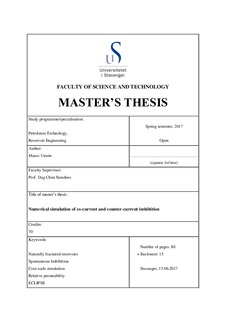| dc.contributor.advisor | Chun Standnes, Dag | |
| dc.contributor.author | Utsetø, Marco | |
| dc.date.accessioned | 2017-10-26T13:43:32Z | |
| dc.date.available | 2017-10-26T13:43:32Z | |
| dc.date.issued | 2017-06-15 | |
| dc.identifier.uri | http://hdl.handle.net/11250/2462420 | |
| dc.description | Master's thesis in Petroleum engineering | nb_NO |
| dc.description.abstract | Spontaneous imbibition (SI) is a very important mechanism for oil recovery in naturally fractured reservoirs. Several studies have indicated that counter-current oil production is much slower and give lower ultimate oil recovery than that of co-current production. This thesis presents an investigation of the relationship between co-current and counter-current relative permeabilities and their effect on production rates and ultimate oil recovery.
SI into strongly water-wet low-permeability chalk has been investigated by numerical simulations using ECLIPSE 100. Two independent experimental studies have been considered, dividing this thesis into two parts. In part 1 counter-current relative permeability curves obtained by history matching experimental data by Standnes (2004) were used in co-current simulations. Unexpected results were found, in which simulations showed too fast oil recovery rates when counter-current relative permeabilities were included in the model. Further investigation showed inconsistency within experimental data and certain SI tests were considered unrepresentative. As further comparison would give inconsistent results, part 2 was introduced.
For part 2, counter-current simulations were run with co-current relative permeability curves established by history matching experimental data by Bourbiaux and Kalaydjian (1990). Too fast oil recovery rates were observed. The half-recovery time was underestimated by approximately 50 %, which is in agreement with results found by Bourbiaux and Kalaydjian (1990). Exact prediction of counter-current experimental data was obtained by reducing both oil and water relative permeabilities including endpoints, by 50 % or by increasing the Corey exponents for oil and water by 45 %, however, with fixed endpoints. Since SI is described by a diffusion equation model, a relationship between the capillary diffusivity coefficient (CDC) and oil recovery curves for certain SI tests was investigated. A relationship is proposed were the oil recovery curve is expressed as a function of CDC value and curve shape (when plotted against normalized water saturation). The numerical investigation in this thesis underlines the importance of considering both co-current and counter-current conditions when evaluating the oil recovery potential on reservoir rocks experimentally, as inconsistencies may arise when results are scaled to reservoir conditions. | nb_NO |
| dc.language.iso | eng | nb_NO |
| dc.publisher | University of Stavanger, Norway | nb_NO |
| dc.relation.ispartofseries | Masteroppgave/UIS-TN-IPT/2017; | |
| dc.subject | petroleumsteknologi | nb_NO |
| dc.subject | petroleum engineering | nb_NO |
| dc.subject | naturally fractured reservoirs | nb_NO |
| dc.subject | core scale simulation | nb_NO |
| dc.subject | spontaneous imbibition | nb_NO |
| dc.subject | reservoir engineering | nb_NO |
| dc.subject | reservoarteknologi | nb_NO |
| dc.title | Numerical simulation of co-current and counter-current imbibition | nb_NO |
| dc.type | Master thesis | nb_NO |
| dc.description.version | submittedVersion | nb_NO |
| dc.subject.nsi | VDP::Technology: 500::Rock and petroleum disciplines: 510::Petroleum engineering: 512 | nb_NO |
